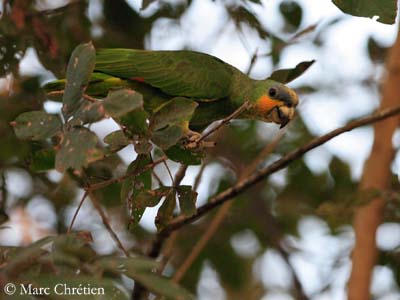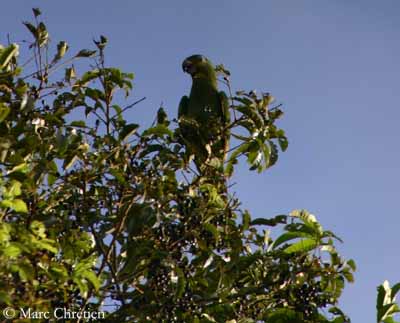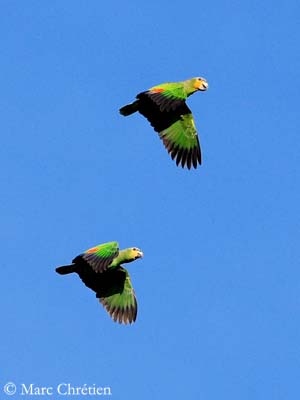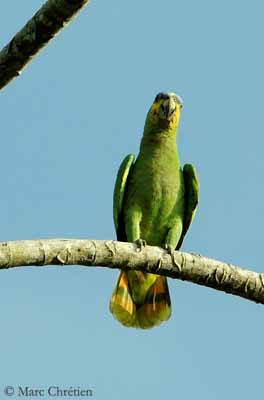
Orange-winged Parrot
Amazona amazonica
Psittaciforme Order – Psittacidae Family
BIOMETRICS:
Length: 31 à 34 cm
Weight: 300 à 470 g
LONGEVITY: up to 60 years
DESCRIPTION:
Orange-winged Parrot is the most widespread parrot in its range, and a common cage bird.
Adult male has green plumage overall. On the wings, primaries are broadly tipped dark blue. Carpal edge is yellow, and we can see an orange-red wing speculum in some birds. Green tail is tipped yellow.
Underparts are green, slightly paler than upperparts, mostly green-yellow. Undertail coverts turn yellowish green, and undertail feathers are orange, crossed by green band, and tipped pale yellow.
On the head, forecrown and cheeks are yellow. Forehead and lores are blue, extending over and behind the eye, as supercilium.
Strong, hooked bill is mainly yellowish, with dark grey tip. Eyes are orange. Legs and feet are grey.
Both sexes are similar, but male has rather blue forehead than female which has more yellow on face.
Immature resembles adults, and it has brown eyes. Young birds reach their sexual maturity at 3 to 4 years of age.
The two subspecies, A.a. amazonica and A.a. tobagensis are just differenced by size of orange-wing speculum.

VOICE: SOUNDS BY XENO-CANTO
Orange-winged Parrot utters wide variety of squawks and whistles when perched. Birds in flight give shrill “kee-wik…kee-wik…kee-wik…kee-wik” in high-pitched tone, and also bysillabic “klee-ak” over and over.
HABITAT:
Orange-winged Parrot lives in lowlands, swampy forests and mangroves, gallery forests and savannahs with scattered trees, and also drier woodlands.
Habitats differ, according to the country. It is rarely seen above 800 metres of elevation.
RANGE:
Orange-winged Parrot is resident and breeds in tropical South America, from N and E Colombia, Trinidad and Tobago, E Peru, N Bolivia, the Guianas and Amazon Basin to N and E Brazil. There is a feral population in Miami, Florida (USA).
BEHAVIOUR:
Orange-winged Parrot feeds on fruit and seeds in early morning and late afternoon, often in mixed flocks with other Amazona species.
These birds are noisy and conspicuous, and also very gregarious. They gather in large groups at communal roosts outside breeding season. They utter loud screams when arrive or leave the roost, gathering first in nearby trees before to perch for the night at roost where often many hundreds of birds can be seen together. Numbers decline at roost during breeding season.

They are often found high in trees or in canopy. When they are not feeding, Orange-winged Parrots, as other parrots, are chewing bark or wood, in order to keep their bill in good condition. Bill is their main “tool” for feeding and climbing into branches. All parrots can crack hard nuts and seeds with their bill and with help of their muscular tongue.

FLIGHT:
Orange-winged Parrot flies high in the air, between roost and feeding area. They usually fly in pairs, and they perform rapid shallow wing beats.
REPRODUCTION:
Breeding season varies, according to the location.
Orange-winged Parrot nests in holes high in trees. They are monogamous and solitary nesters.
Female lays 2 to 5 white eggs. Incubation lasts about 21 days, only by female. During the day, male remains close to the nest, and roosts at communal roost at night.
Young are fed by both parents, and fledge about two months after hatching.
DIET:
Orange-winged Parrot feeds on fruits, seeds, berries, nuts, flowers, blossoms and leaf buds.
Groups feed on cultivated fruits such as oranges, mangoes and cocoa. They sometimes are considered a pest because they can damage cultivated areas.
They forage along forest edges, around plantations and in urban areas. They are silent while feeding. The only noise we ear is some movement of leaves.

PROTECTION / THREATS / STATUS:
Orange-winged Parrot is widespread and common in most part of its range. But in some places, such as Trinidad and Tobago, it can be classified as pest.
They also are game birds and it is allowed to hunt them in some periods. Hunting in French Guyana has been excessive some years ago. Adults are killed for their flesh, and young are raised for trade.
Orange-winged Parrot is a common cage bird, and it is heavily trapped for trade.
In some parts of the range, deforestation causes declines. However, Orange-winged Parrots are abundant and common.
Fr: Amazone aourou
All: Venezuelaamazone
Esp: Amazona Alinaranja
Ital: Amazzone ali arancioni
Nd: Oranjevleugelamazone
Russe: Венесуэльский Амазон
Sd: Orangevingad amason
Photographs by Marc Chrétien
His website :
MURINUS
Text by Nicole Bouglouan
Sources:
HANDBOOK OF THE BIRDS OF THE WORLD vol 4 by Josep del Hoyo-Andrew Elliott-Jordi Sargatal - Lynx Edicions - ISBN: 8487334229
PARROTS OF THE WORLD – An Identification Guide – by Joseph M. Forshaw – Princeton University Press – ISBN 0691092516
A GUIDE TO THE BIRDS OF COLOMBIA by Steven L. Hilty and William L. Brown
Princeton University Press – ISBN 069108372X
Wikipedia (Wikipedia, The Free Encyclopedia)
What Bird-The ultimate Bird Guide (Mitchell Waite)